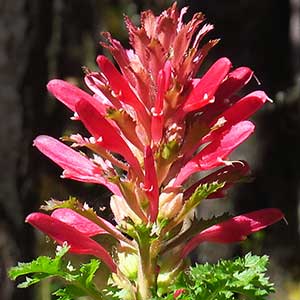Pedicularis densiflora
Pedicularis oederi
Indian warrior, warrior's plume
Oeder's lousewort
basal 1–10, blade lanceolate, 30–200 x 20–70 mm, 2(or 3)-pinnatifid, margins of adjacent lobes nonoverlapping or extensively overlapping distally, 1-serrate, surfaces glabrous, hispid, or downy;
cauline 4–20, blade lanceolate, 15–250 x 5–100 mm, 2-pinnatifid, margins of adjacent lobes nonoverlapping or extensively overlapping distally, serrate, surfaces glabrous, hispid, or downy.
basal 2–10, blade lanceolate, 10–70 x 3–15 mm, 1-pinnatifid, margins of adjacent lobes nonoverlapping or extensively overlapping distally, 2-serrate, surfaces glabrous or slightly tomentose;
cauline 1–5, blade lanceolate, 15–50 x 3–20 mm, 1-pinnatifid, margins of adjacent lobes nonoverlapping or extensively overlapping distally, 1- or 2-serrate, surfaces glabrous or slightly tomentose.
simple, 1–5, exceeding basal leaves, each 10–50-flowered;
bracts lanceolate to trullate, 10–35 x 3–5 mm, undivided or 1-pinnatifid, proximal margins entire, distal 1- or 2-serrate, surfaces glabrous.
simple, 1 or 2, exceeding basal leaves, each 10–50-flowered;
bracts linear to lanceolate, 5–20 x 1–2 mm, undivided or 1-pinnatifid, proximal margins entire, distal serrate, surfaces glabrous or tomentose.
2–4 mm.
2–5 mm.
calyx 9–18 mm, downy to tomentose, lobes 5, triangular, 3–4 mm, apex entire, ciliate;
corolla 23–43 mm, tube dark red, purple, or orange-yellow, rarely white, 8–18 mm;
galea dark red, purple, or orange-yellow, rarely white, 15–25 mm, beakless, margins entire medially and distally, apex straight;
abaxial lip dark red, purple, or orange-yellow, rarely white, 8–15 mm.
calyx 8–11 mm, tomentose, lobes 5, triangular, 1–3 mm, apex entire or serrate, glabrous, sometimes ciliate;
corolla 15–24 mm, tube yellow, 9–15 mm;
galea bicolored, yellow proximally, brown or red distally, 6–9 mm, beakless, margins entire medially and distally, apex arching slightly over abaxial lip;
abaxial lip yellow, 4–5 mm.
= 16.
= 16 (Asia).
Pedicularis densiflora
Pedicularis oederi
Scarlet corollas with an undomed, toothless galea and two- or three-pinnatifid leaves are diagnostic of Pedicularis densiflora. This species occurs in forested subalpine regions of southern Oregon, western slopes of the Sierra Nevada, and the Coast Ranges of California south to Baja California. Herbarium records indicate northern populations of P. densiflora occur at higher elevations than do more southern populations.
(Discussion copyrighted by Flora of North America; reprinted with permission.)
Pedicularis oederi is known from the mountains of Europe, Asia, and western North America.
Two arctic species can be easily confused with Pedicularis oederi. Pedicularis flammea also has bicolored flowers that are yellow with galeas that are red- or purple-tipped, but the flowers of P. oederi are twice the size of those of P. flammea. The flowers of P. capitata are sometimes also yellow but may or may not be bicolored. If bicolored, the color is more diffuse and lighter than that of either P. flammea or P. oederi. The flowers of P. capitata are also larger than those of P. oederi. In addition, the inflorescences of P. capitata usually have no more than five flowers clustered at the tips, while those of P. oederi have at least 10 to 50 flowers along at least one third their lengths. H. J. Scoggan (1978–1979) listed P. oederi var. albertae based upon its densely woolly inflorescence.
(Discussion copyrighted by Flora of North America; reprinted with permission.)


